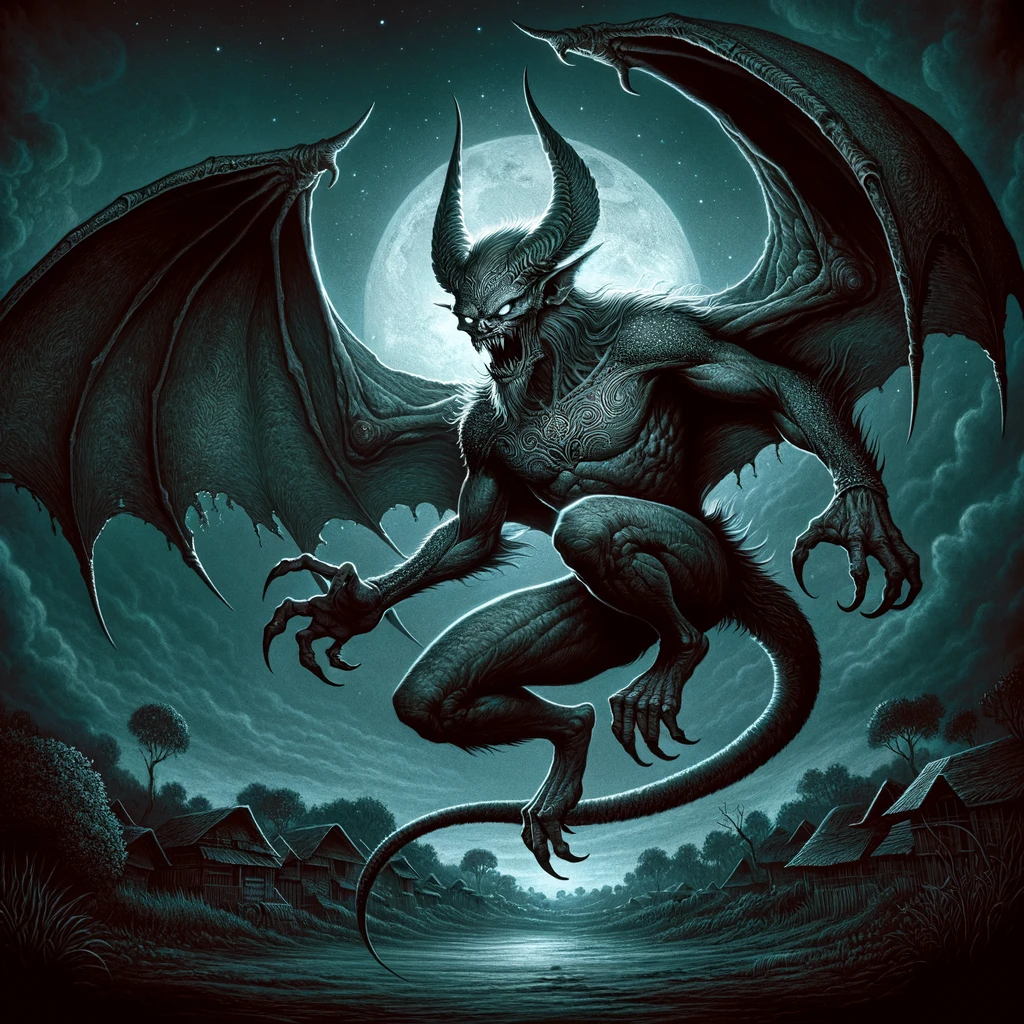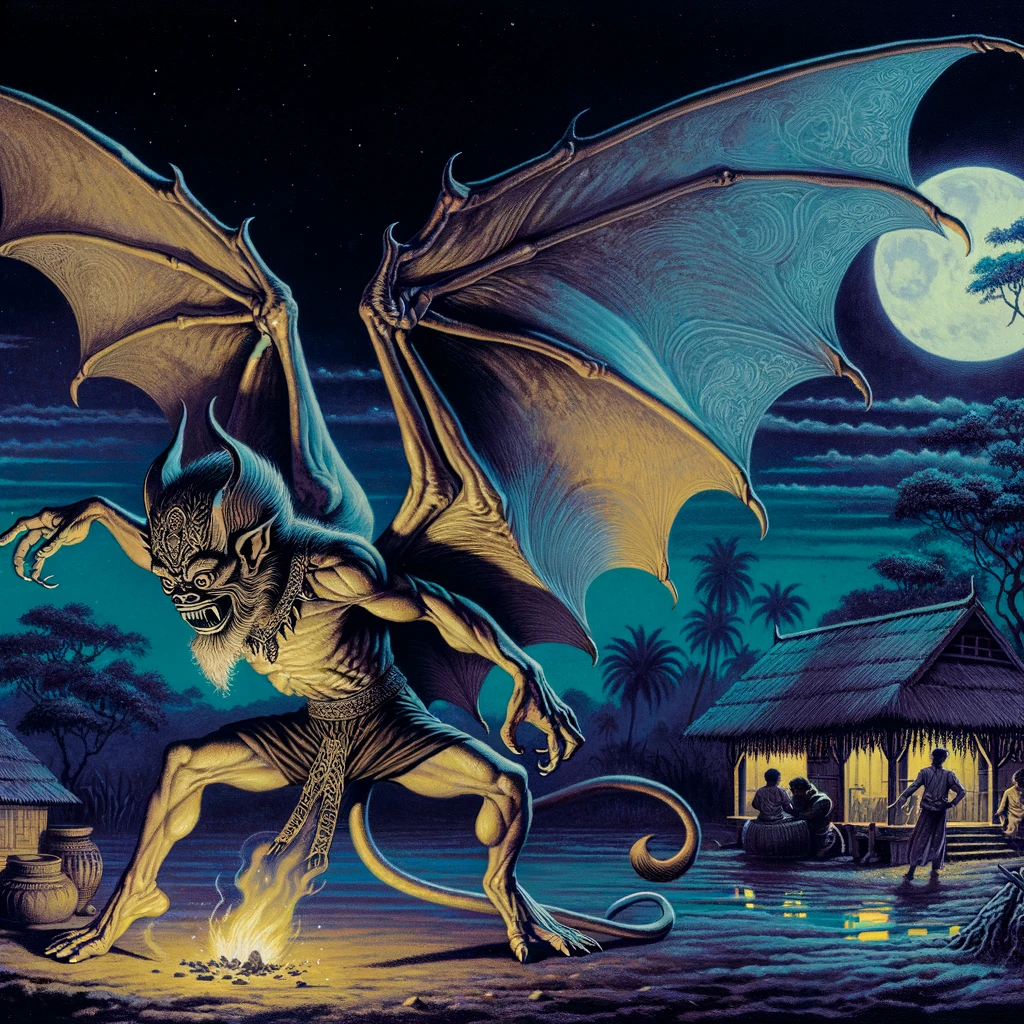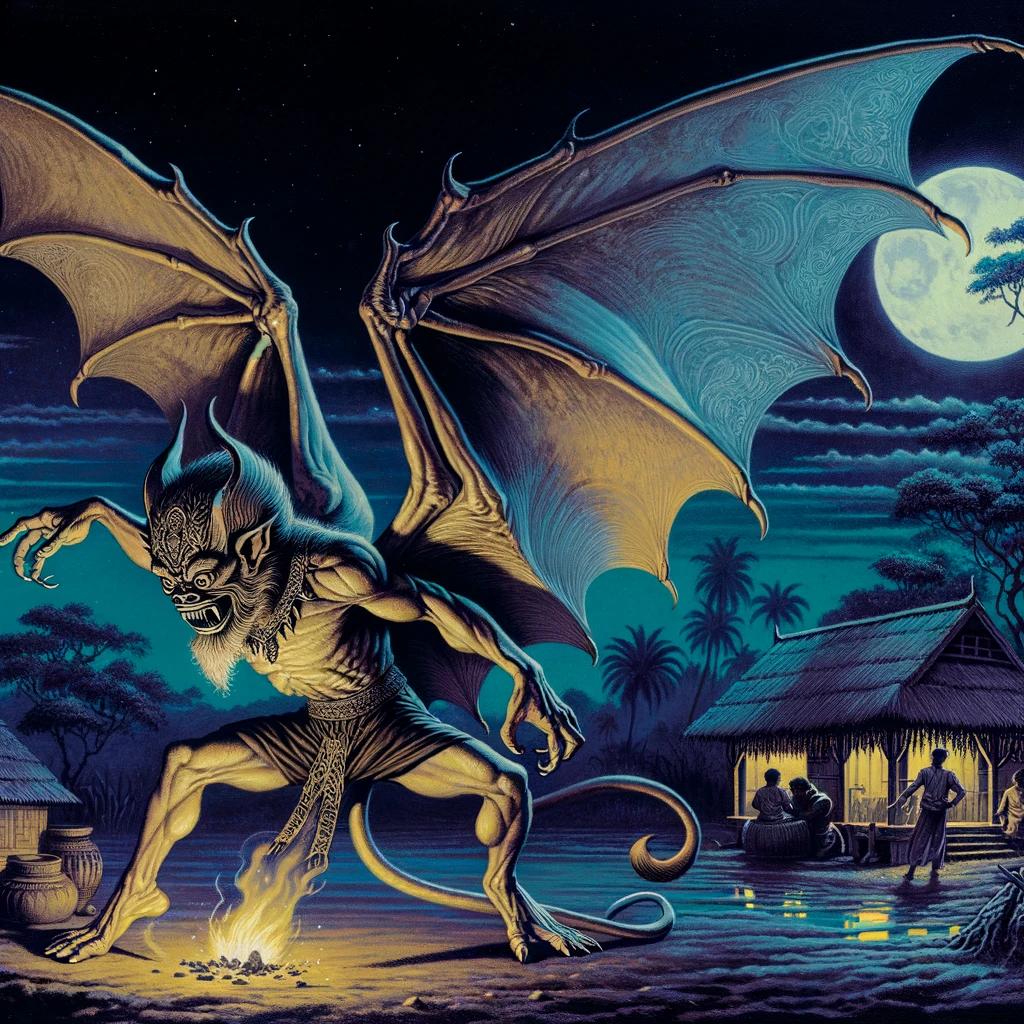Manananggal is a mythical creature that originated in the Philippines. It is a popular figure in Filipino folklore and is often depicted as a terrifying, blood-sucking monster that preys on pregnant women and fetuses. The creature is known for its ability to sever its upper torso from its lower torso and sprout huge bat-like wings to fly into the night in search of its victims.
The word manananggal comes from the Tagalog word tanggal, which means “to remove” or “to separate.” The creature is said to be able to separate its upper body from its lower body by using its sharp teeth or a special potion. Once separated, the upper body grows wings and flies off in search of prey, leaving the lower body behind. The creature is often depicted as a female, and is said to be particularly attracted to pregnant women and fetuses, which it feeds on by using its elongated tongue to puncture the abdomen of its sleeping victims.

Despite its terrifying reputation, the manananggal is an important part of Filipino folklore and is often used in popular culture to symbolize the fears and anxieties of the Filipino people. The creature has been the subject of numerous books, movies, and TV shows, and is a popular Halloween costume in the Philippines. While the manananggal is certainly a frightening creature, it is also a fascinating example of the rich cultural heritage of the Philippines.
Manananggal: An Overview
Manananggal is a mythical creature that originated in the Philippines. It is often depicted as a female creature with bat-like wings and is known for its ability to sever its upper torso and fly into the night in search of its victims. The name “Manananggal” comes from the Tagalog word “tanggal,” which means “to separate.”
The Manananggal is a creature that strikes fear in the hearts of many Filipinos. It is described as hideous, scary, and often depicted as a monster. The creature is also known for its vampiric tendencies, as it is said to be man-eating and blood-sucking.

According to Philippine mythology, the Manananggal is vulnerable to garlic, salt, and sunlight. It is also believed that it can be killed by driving a stake through its heart or by exposing it to sunlight.
Despite being a creature of myth, the Manananggal has captured the imagination of many Filipinos and has become a popular subject in Philippine folklore. It has been featured in movies, television shows, and literature.
Overall, the Manananggal is a creature that has fascinated and terrified people for generations. Its ability to separate its upper torso and fly into the night, coupled with its vampiric tendencies, has made it a popular subject in Philippine mythology and popular culture.
Physical Description
The manananggal is a mythical creature in Philippine folklore that is known for its ability to separate its upper torso from the lower part of its body. It has a vampire-like appearance with fangs and bat-like wings. The creature is said to be an older, beautiful woman capable of severing its upper torso in order to fly into the night and prey on unsuspecting, sleeping pregnant women in their homes.

Upper Torso
The upper torso of the manananggal is described as being grotesque and hideous. It is said to have sharp fangs and teeth that are used to puncture the abdomen of a sleeping victim. Using its elongated proboscis-like tongue, the creature feeds on the unborn child’s blood or amniotic fluid. The manananggal also feasts on the entrails of its victims, leaving a gruesome trail in its wake.
Lower Torso
The lower torso of the manananggal is often left behind when the creature separates its upper torso to fly. It is described as being a grotesque, fleshy mass that is left behind while the creature is out hunting for its next victim.
Wings
The manananggal’s wings are bat-like in appearance and are used to fly through the night sky. They are said to be large and leathery, allowing the creature to glide through the air with ease. The wings are also one of the creature’s weaknesses, as sunlight is deadly to the manananggal when she is in her monstrous form.
Tongue
The proboscis-like tongue of the manananggal is used to puncture the abdomen of its victims. It is said to be elongated and flexible, allowing the creature to reach its prey even when they are sleeping. The tongue is also used to feed on the entrails of its victims.
In summary, the manananggal is a fearsome creature with a grotesque appearance. Its ability to separate its upper torso from its lower body, its bat-like wings, and its elongated proboscis-like tongue make it a formidable foe. Despite its fearsome abilities, the manananggal is not without its weaknesses, as sunlight is deadly to the creature when it is in its monstrous form.
Hunting and Feeding Habits
Prey
Manananggal is known for hunting pregnant women and their fetuses. According to USC Digital Folklore Archives, the monster detaches its upper body from its legs and flies at night to feed on the babies. The monster is said to have a long proboscis-like tongue that it uses to suck the blood of the fetuses. The Manananggal’s name is derived from the Tagalog word “tanggal,” which means “to separate,” because of the creature’s ability to separate itself from its lower body.
Feeding Process
The Manananggal feeds on the insides of its prey, particularly the blood of pregnant women and their fetuses. The creature’s long proboscis-like tongue is used to suck the blood of the fetuses, which it does after detaching its upper body from its legs. According to LoreThrill, the Manananggal likes to feed on the insides of its prey, and it is known to be a vicious and blood-sucking creature.
The only way to kill the Manananggal is to put salt on the lower part of its body, according to USC Digital Folklore Archives. The creature is said to be vulnerable to salt, and it will die if it comes into contact with it.
In conclusion, the Manananggal is a monster that is known for its ability to detach its upper body from its legs and fly at night to feed on pregnant women and their fetuses. The creature’s long proboscis-like tongue is used to suck the blood of the fetuses, and it is known to be a vicious and blood-sucking creature. The only way to kill the Manananggal is to put salt on the lower part of its body.
Transformation and Severing Process
Severing Process
The manananggal is a mythical creature from the Philippines that is known for its ability to sever its upper torso and sprout wings to fly into the night in search of its victims. The process of severing is said to be painful and involves the creature using its sharp teeth to bite through its own flesh. According to Wikipedia, the creature then uses a vinegar-like substance to prevent the lower half of its body from moving while it flies away.
Transformation
During the day, the manananggal disguises itself as a beautiful woman, but at night it transforms into an evil creature. The transformation process is said to be equally painful and involves the creature rubbing its body with a special oil called “lana.” The oil is made from a mixture of coconut oil, herbs, and the fat of a black cat. Once the oil is applied, the creature begins to transform, growing wings and developing sharp claws.
According to Medium, the transformation process can take up to an hour to complete, during which time the creature is said to be in extreme pain. Once the transformation is complete, the creature is able to fly and hunt for its victims.
To remove the manananggal from its victims, a special process must be followed. According to VampireFacts.net, a person must find the creature’s lower half and sprinkle salt or garlic on it. This will prevent the lower half from reattaching itself to the upper half, allowing the creature to be killed. Alternatively, the lower half can be destroyed, which will also kill the creature.
Overall, the transformation and severing process of the manananggal is a gruesome and painful affair. The creature is able to use its abilities to hunt and kill its victims, making it a terrifying legend in Philippine folklore.
Weaknesses and Vulnerabilities
Sunlight
Like many creatures of the night, the Manananggal is vulnerable to sunlight. Exposure to sunlight can be deadly for the creature, especially when it is in its monstrous form. According to Myth and Folklore Wiki, if the Manananggal is caught outside during the day and its two halves are still separated with the coming of dawn, it will be destroyed.

Salt and Garlic
The Manananggal is also vulnerable to certain substances, such as salt and garlic. These substances are believed to have purifying properties that can weaken or repel the creature. According to USC Digital Folklore Archives, hanging garlic or salt outside a house or placing them on windowsills can keep the Manananggal away.
Ash
Ash is another substance that is believed to weaken the Manananggal. According to Cryptid Wiki, sprinkling ash around the house or on the Manananggal’s lower torso can prevent it from reattaching its halves.
Vinegar
Vinegar is another substance that is believed to be effective against the Manananggal. According to Cryptid Wiki, soaking clothes in vinegar and hanging them outside the house can keep the creature away.
Stingray Tail
The Manananggal is also vulnerable to the tail of a stingray. According to Wikipedia, the tail of a stingray is believed to be a powerful weapon against the creature. It is said that striking the Manananggal with a stingray tail can kill it instantly.
In conclusion, the Manananggal is a fearsome creature with several weaknesses and vulnerabilities. While sunlight, salt, garlic, ash, vinegar, and the tail of a stingray can be effective against it, it is important to note that these methods may not always work. It is best to avoid encountering the creature altogether.
Manananggal in Folklore and Mythology
Philippine Folklore
Manananggal is a well-known mythical creature in Philippine folklore and mythology. It is believed to be a female monster that can separate its upper torso from the lower part of its body. The creature is said to have bat-like wings and sharp fangs, giving it a vampire-like appearance. According to Philippine folklore, the manananggal preys on pregnant women and their fetuses, as well as young children.
The manananggal is commonly found in the Visayan region of the Philippines, and its name is derived from the Tagalog phrase “manananggal,” which means “one who separates itself.” The creature is often associated with the tik-tik, a bird-like creature that is said to serve as a warning of the manananggal’s presence.
Malaysian Folklore
In Malaysian folklore, the manananggal is known as the “penanggalan,” which is similar to the Philippine version of the creature. The penanggalan is described as a female monster that can detach its head from its body and fly around at night. It is said to prey on pregnant women and children, and its presence is often accompanied by a foul odor.
Indonesian Folklore
In Indonesian folklore, the manananggal is known as the “leak,” which is also similar to the Philippine and Malaysian versions of the creature. The leak is described as a female monster that can detach its head from its body and fly around at night. It is said to be a type of demon or evil spirit, and its presence is often accompanied by a foul odor.
In all three versions of the creature, the manananggal is often associated with other folklore creatures such as the aswang, ose, vampire, and oni. The manananggal is also associated with stories of devils and demons, and is often depicted as an evil spirit that preys on the innocent.
Overall, the manananggal is a fascinating creature that has captured the imagination of people in the Philippines, Malaysia, and Indonesia for generations. Its appearance in folklore and mythology serves as a reminder of the power of storytelling and the enduring nature of myths and legends.
Manananggal in Media
The Manananggal, being a popular mythical creature in Philippine folklore, has made its way into various forms of media. From films to art galleries, the creature has been depicted in different ways.
Films
Several films have featured the Manananggal as the main antagonist. One of the earliest films was the 1965 black and white movie, “The Blood Drinkers” directed by Gerardo de Leon. In this film, the Manananggal is portrayed as a vampire-like creature who preys on pregnant women.
Another notable film is the 2016 horror-thriller, “The Woman Who Left,” directed by Lav Diaz. The film tells the story of a woman who returns to her hometown after being wrongfully imprisoned for 30 years. She discovers that a Manananggal is terrorizing the town and decides to take matters into her own hands.
Gallery
The Manananggal has also been featured in various art galleries. One of the most notable galleries was the “Manananggal: A National Myth” held at the Cultural Center of the Philippines in 2017. The exhibit showcased different interpretations of the creature through paintings, sculptures, and installations.
In addition, the Manananggal has also been featured in comic books and graphic novels. One of the most popular graphic novels is “Trese” by Budjette Tan and Kajo Baldisimo. The series follows the adventures of Alexandra Trese, a detective who investigates supernatural crimes in Manila. In one of the volumes, she encounters a Manananggal who is terrorizing a village.
Overall, the Manananggal has become a staple in Philippine media, with its popularity continuing to grow. Its depiction varies depending on the medium, but its essence as a terrifying creature remains the same.
Books
The Manananggal, a fascinating creature from Philippine folklore, has found its way into several notable books. Here are three prominent examples, each offering a unique interpretation of this mythical being:
- “Manananggal Terrorizes Manila and Other Stories” by Jessica Zafra
- Synopsis: This collection of short stories by Jessica Zafra, a well-known Filipino writer, features a mix of contemporary and fantastical themes. One of the stories vividly brings the Manananggal to life, setting it against the backdrop of modern-day Manila. The tale explores the intersection of urban life and mythical folklore, presenting the Manananggal in a contemporary setting, which adds a layer of surrealism to the everyday life of Filipinos.
- “Waking the Dead and Other Horror Stories” by Yvette Tan
- Synopsis: Yvette Tan, a celebrated author in the Philippine horror genre, presents a collection of spine-chilling stories, including narratives featuring the Manananggal. Her depiction stays true to the creature’s traditional roots while weaving it into narratives that resonate with modern Filipino society. The book offers a blend of horror and cultural reflection, showcasing the Manananggal in scenarios that range from terrifying to bizarrely humorous.
- “Smaller and Smaller Circles” by F.H. Batacan
- Synopsis: While not featuring the Manananggal in a literal sense, this novel by F.H. Batacan, a pioneer of the Filipino crime novel genre, includes references to various aspects of Philippine folklore, including the Manananggal. The book is a gripping crime thriller set in Manila, where two Jesuit priests work as forensic investigators. The story delves into the dark underbelly of the city, and the Manananggal serves as a symbolic representation of the unseen horrors lurking within society.
Manananggal in Society
The Manananggal is a popular mythical creature in the Philippines that has been a part of the country’s folklore for centuries. It is a female monster that is often depicted as having a bat-like appearance, with wings and fangs. The Manananggal is believed to prey on pregnant women, grooms, and couples, and is known for its ability to separate its upper torso from the lower part of its body.
Capiz
Capiz is a province in the Western Visayas region of the Philippines, and is known for its rich history and culture. It is also known as the “Land of the Aswang,” a term used to describe various supernatural creatures in Philippine folklore, including the Manananggal. In Capiz, the Manananggal is believed to be a powerful creature that can only be defeated by certain rituals and practices.
Iloilo
Iloilo is another province in the Western Visayas region of the Philippines, and is known for its beautiful beaches and historic landmarks. The Manananggal is also a popular creature in Iloilo, and is often depicted as a bloodthirsty monster that preys on unsuspecting victims. In Iloilo, the Manananggal is believed to be a powerful creature that can only be defeated by certain rituals and practices.
Antique
Antique is a province in the Western Visayas region of the Philippines, and is known for its beautiful natural scenery and rich cultural heritage. The Manananggal is also a popular creature in Antique, and is often depicted as a bloodthirsty monster that preys on unsuspecting victims. In Antique, the Manananggal is believed to be a powerful creature that can only be defeated by certain rituals and practices.
Overall, the Manananggal is an important part of Philippine folklore and has played a significant role in shaping the country’s culture and history. While the creature is often associated with fear and terror, it is also a symbol of resilience and strength, as it has survived in the country’s folklore for centuries.
Conclusion
In conclusion, the Manananggal is a fascinating creature that has captured the imagination of people in the Philippines and beyond. According to Wikipedia, the Manananggal is a mythical creature that is able to separate its upper torso from the lower part of its body, and its fangs and wings give it a vampire-like appearance. It is feared for its ability to prey on pregnant women and their unborn children, and it is said to be repelled by garlic, salt, and vinegar.
The Manananggal has also been the subject of literary analysis. According to a study published on ResearchGate, the Manananggal’s devouring can be read in several interconnected ways. First, it may reflect the fear of people of the unborn child being devoured and destroyed. Second, it may reflect the fear of women who are capable of such a monstrous act. Finally, it may represent the fear of colonialism and the destruction of Philippine culture.
Overall, the Manananggal is a complex and multifaceted creature that continues to intrigue and captivate people to this day. Whether it is viewed as a symbol of fear, a subject of scientific research, or a literary device, the Manananggal remains an enduring part of Philippine mythology and culture.






